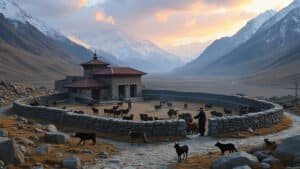Introduction
Compensation programs have emerged as a key solution to conserving snow leopards while addressing the economic challenges faced by local communities
These initiatives aim to reduce human-wildlife conflict, particularly in regions where snow leopards prey on livestock, causing financial strain on herders. By providing monetary compensation for livestock losses, such programs discourage retaliatory killings and foster a sense of coexistence
In this article, we explore the mechanisms of compensation programs, their role in minimizing conflict, and their benefits for snow leopard conservation. Additionally, we discuss case studies, challenges, and the sustainability of these initiatives to highlight their effectiveness in protecting this endangered species
What Are Compensation Programs in Snow Leopard Conservation?
Compensation programs are financial mechanisms designed to mitigate human-wildlife conflict by reimbursing communities, particularly livestock herders, for economic losses caused by wildlife
In the case of snow leopard conservation, these programs address the recurring issue of livestock predation by snow leopards, which often leads to retaliatory killings
By offering direct financial compensation, these initiatives create incentives for herders to tolerate the presence of snow leopards in their habitats rather than perceiving them as a threat to their livelihoods
Definition and Purpose of Compensation Programs
Compensation programs are structured systems that provide monetary support to livestock owners when their animals are killed by snow leopards. Their primary purpose is twofold: to offset the economic losses suffered by herders and to promote the protection of snow leopard populations
Snow leopards, classified as vulnerable by the International Union for Conservation of Nature (IUCN), face a significant threat from retaliatory killings, as livestock predation often results in severe financial hardship for rural communities
The concept of compensation programs arises from the need to reconcile wildlife conservation efforts with the economic well-being of local populations. For example, herders in the Himalayas or Central Asia rely heavily on livestock for income and subsistence
When snow leopards attack livestock, the financial losses can be devastating, particularly in impoverished areas. Compensation programs ensure that herders are not forced to choose between their livelihood and wildlife conservation
Historical Background of Compensation Initiatives
The implementation of compensation programs in snow leopard conservation gained traction in the late 20th century as researchers and conservationists recognized the impact of livestock predation on human-wildlife relationships
Early initiatives often relied on ad hoc support from conservation organizations and local governments. For instance, the Snow Leopard Trust (SLT), one of the leading organizations in snow leopard conservation, began promoting compensation schemes in the 1990s to curb retaliatory killings in countries like Mongolia, India, and Kyrgyzstan
One of the first documented compensation programs was established in Ladakh, India, where snow leopard predation on livestock was a persistent challenge
Researchers like Chandra Mishra (2003) pioneered studies showing that financial incentives and community-based approaches could reduce conflict and promote conservation outcomes. Over time, these programs evolved to include mechanisms for verifying predation claims, ensuring transparency, and building trust among local communities
Types of Compensation Models for Livestock Losses
Compensation programs for snow leopard conservation are implemented using different models, depending on the socioeconomic and ecological context of the region
The most common models include:
Direct Payment Compensation: Under this model, herders receive direct monetary reimbursement for confirmed cases of livestock loss due to snow leopard attacks. For example, in Kyrgyzstan, conservation organizations work with local communities to document and verify kills before compensation is issued
Insurance-Based Compensation: In this model, herders pay a small premium into a community-managed insurance fund. If their livestock is predated, they receive a payout from the fund. This approach has been successful in regions like northern India, where the Snow Leopard Trust runs insurance programs with local communities
Performance-Based Incentives: Some programs tie compensation to community conservation efforts. For instance, herders may receive funds if no snow leopards are killed in their region over a specific period. This model incentivizes communities to actively participate in protecting snow leopards
Each model has its advantages and challenges. Direct payments are often simpler to implement but can face issues of transparency and verification. Insurance-based models encourage community ownership but require effective fund management
Performance-based incentives align conservation goals with economic benefits but may require ongoing monitoring
Case Studies from Snow Leopard Range Countries
Several case studies highlight the success of compensation programs in mitigating human-snow leopard conflict:
Ladakh, India: The Snow Leopard Trust and Nature Conservation Foundation implemented an insurance-based compensation program where herders contribute a small premium to a community-managed fund. Claims are verified by trained individuals, ensuring transparency and trust. Over time, this program reduced retaliatory killings and fostered community support for snow leopard conservation
Mongolia: The Snow Leopard Enterprises program combines compensation with sustainable income generation. Herders are compensated for livestock losses while also earning money through the sale of handicrafts. This integrated approach addresses both financial losses and poverty, further reducing conflict
Kyrgyzstan: In Kyrgyzstan, direct payment programs led by the Snow Leopard Trust have been instrumental in reducing retaliatory killings. Herders are compensated for verified livestock losses, and conservation organizations work closely with communities to raise awareness about the ecological importance of snow leopards
These case studies demonstrate that compensation programs are adaptable and effective when tailored to the specific needs of local communities. By addressing the root causes of human-wildlife conflict—economic loss and mistrust—these programs have proven to be an essential tool in snow leopard conservation
How Compensation Programs Reduce Human-Wildlife Conflict
Human-wildlife conflict, particularly in regions where snow leopards roam, has long been a critical challenge to conservation efforts. Snow leopards are often blamed for preying on livestock, which provides a vital source of income and sustenance for rural communities
This economic loss frequently triggers retaliatory killings of snow leopards, threatening their already vulnerable populations. Compensation programs are designed to address this issue by directly mitigating the economic burden on herders and encouraging peaceful coexistence with snow leopards
Addressing Economic Losses for Herders
For rural communities in snow leopard habitats, livestock is often the backbone of their livelihoods
In mountainous regions across Central and South Asia, where agriculture is difficult due to rugged terrain and extreme weather, families rely on sheep, goats, and yaks for food, trade, and income. When a snow leopard kills livestock, the financial loss can be devastating, particularly for families already living below the poverty line
Compensation programs play a pivotal role by reimbursing herders for these losses. By receiving fair and timely compensation, herders are less likely to view snow leopards as a direct threat to their survival. For instance, in the Spiti Valley of India, compensation programs managed by conservation organizations like the Snow Leopard Trust (SLT) and Nature Conservation Foundation (NCF) have provided critical financial relief to herders
A herder who loses a yak, which can be valued at over $400, receives compensation, offsetting a significant economic setback. This financial security creates a foundation for fostering tolerance and reducing retaliatory killings
Studies show that in regions with active compensation programs, incidents of snow leopard poaching and retaliatory killing decline significantly
According to Mishra et al. (2003), communities participating in compensation initiatives reported a measurable decrease in snow leopard killings compared to areas without such programs. By alleviating economic hardship, these initiatives provide herders with a tangible incentive to conserve snow leopards rather than eliminate them
Incentivizing Coexistence with Snow Leopards
One of the primary goals of compensation programs is to shift human perceptions of snow leopards from being a nuisance to a valued part of the ecosystem. By providing financial support, these programs incentivize coexistence, where communities recognize that protecting snow leopards can lead to long-term benefits
Some programs take this a step further by combining compensation with community rewards. For example, in Kyrgyzstan, community-based conservation programs offer bonus payments to villages that maintain snow leopard populations without retaliation
These payments encourage a collective responsibility to protect snow leopards, fostering a culture of coexistence within entire communities
In regions like Mongolia, performance-based compensation systems have successfully encouraged herders to monitor snow leopards and prevent poaching
The Snow Leopard Trust’s performance-payment model rewards communities when no snow leopards are harmed within a designated timeframe. This creates a financial incentive for communities to protect the cats actively, transforming them into stewards of conservation
Preventing Retaliatory Killings of Snow Leopards
Retaliatory killings are one of the leading causes of snow leopard mortality. Frustrated herders, left with no economic recourse after livestock losses, often resort to poisoning, trapping, or shooting snow leopards
This practice not only harms snow leopard populations but also disrupts local ecosystems, as snow leopards play a key role in maintaining the balance of their mountainous habitats
Compensation programs directly address the root cause of these retaliatory killings—economic loss. By ensuring that herders are fairly compensated for their losses, these programs eliminate the need for retribution
For example, a study conducted by Hussain (2000) in Pakistan’s Gilgit-Baltistan region found that compensation programs reduced retaliatory killings by 55% within the first five years of implementation
To ensure long-term success, compensation programs often incorporate robust verification processes to confirm predation by snow leopards. Trained local monitors assess livestock kills, ensuring that compensation funds are used effectively and that trust is built among community members
This transparency helps eliminate potential misuse of funds and further reinforces community support for the program
Promoting Long-Term Attitudinal Change Toward Snow Leopards
Changing human attitudes toward snow leopards is essential for the long-term success of conservation efforts
Compensation programs not only address immediate economic concerns but also serve as a platform for education and awareness. By demonstrating that snow leopards can coexist with human activities, these programs gradually foster positive perceptions of the species
For instance, educational outreach programs are often integrated with compensation initiatives. In Nepal, organizations like the Snow Leopard Conservancy provide herders with training on livestock protection methods, such as building predator-proof corrals
These efforts, combined with compensation, reduce livestock losses while building trust in conservation initiatives. Over time, communities begin to view snow leopards not as enemies but as integral components of a balanced ecosystem
Furthermore, compensation programs often highlight the broader ecological importance of snow leopards. As apex predators, snow leopards regulate prey populations, ensuring healthy grasslands and biodiversity. By promoting awareness of these ecological roles, conservation programs help shift the narrative from conflict to coexistence
Benefits of Compensation Programs for Snow Leopards
Compensation programs offer numerous benefits for snow leopard conservation, providing both immediate and long-term solutions to the challenges posed by human-wildlife conflict
These programs not only ensure the survival of snow leopards but also contribute to biodiversity, community engagement, and global awareness of conservation needs
By directly addressing the root causes of conflict—primarily economic losses—compensation programs have proven to be a cornerstone of modern conservation strategies for this vulnerable species
Conserving Snow Leopard Populations
Snow leopards (Panthera uncia), listed as vulnerable by the IUCN, face multiple threats, including habitat loss, climate change, and poaching
However, retaliatory killings remain one of the primary drivers of snow leopard mortality. Compensation programs have a direct and measurable impact on reducing these killings by addressing the financial losses incurred by herders when their livestock are predated
For example, in Mongolia and parts of India, where compensation initiatives have been active, studies have reported a significant decline in the number of snow leopards killed in retaliation
A study by Mishra et al. (2010) revealed that in areas with compensation programs, snow leopard populations stabilized due to decreased conflict. By mitigating the economic toll of livestock losses, these programs alleviate herders’ frustrations and eliminate the perceived need for retaliation
Moreover, compensation initiatives help conservation organizations monitor snow leopard populations more effectively. By fostering trust and cooperation with local communities, these programs encourage herders to report snow leopard sightings and incidents of predation
This reporting improves scientific data collection, enabling conservationists to track snow leopard movements, population trends, and health
Supporting Biodiversity and Ecosystem Health
Snow leopards are apex predators, playing a crucial role in maintaining the ecological balance of their habitats
They regulate prey populations, such as wild goats (ibex) and sheep (argali), which in turn prevents overgrazing and promotes the health of mountain grasslands. These ecosystems support diverse plant and animal species, contributing to regional biodiversity
Compensation programs help protect snow leopard populations, ensuring that they continue to fulfill their role as keystone species. When herders receive compensation for livestock losses, they are less likely to engage in harmful practices, such as indiscriminate trapping or poisoning, which can inadvertently harm other wildlife
For example, in Kyrgyzstan and Nepal, conservation programs have observed reduced use of poisons and traps following the implementation of compensation schemes. This not only benefits snow leopards but also protects other predators, such as wolves, lynx, and birds of prey, that share the same habitats
Additionally, maintaining healthy snow leopard populations indirectly supports local ecosystems that provide critical resources, such as clean water, for both wildlife and human communities
Snow leopard habitats in the Himalayas, for instance, are sources of major river systems that sustain millions of people downstream. By conserving snow leopards, compensation programs contribute to broader ecological and human welfare
Engaging Local Communities in Conservation
One of the most significant benefits of compensation programs is their ability to engage local communities as active participants in conservation
Historically, conservation initiatives that excluded local stakeholders often faced resistance and failed to achieve lasting results. Compensation programs, however, prioritize community involvement, recognizing that sustainable conservation requires local buy-in
Programs like those led by the Snow Leopard Trust and Panthera work directly with herders to develop compensation schemes tailored to their needs
These programs provide training, education, and tools for mitigating livestock losses, such as predator-proof corrals and livestock-guarding techniques. In return, communities agree to refrain from retaliatory killings and report incidents of predation
In addition to financial compensation, some programs provide alternative livelihood opportunities to reduce economic dependence on livestock. For example, the Snow Leopard Enterprises program in Mongolia and Kyrgyzstan supports women in producing and selling handicrafts, creating supplemental income for households
By diversifying livelihoods, these initiatives reduce the economic impact of livestock losses and foster a more positive perception of snow leopards
Community-driven approaches also empower local residents to take pride in conservation efforts. In Ladakh, India, herders actively participate in snow leopard monitoring, helping researchers collect data on snow leopard populations and behavior
This involvement fosters a sense of ownership and stewardship, ensuring that conservation efforts are both culturally and economically sustainable
Generating Global Awareness and Support
Compensation programs not only benefit local communities and snow leopard populations but also raise global awareness about the challenges of snow leopard conservation. By highlighting the plight of herders and the importance of coexistence, these programs attract funding and support from international organizations, governments, and donors
For example, global campaigns led by organizations like the Snow Leopard Trust and the Global Snow Leopard and Ecosystem Protection Program (GSLEP) have successfully raised awareness and funding for compensation initiatives
These efforts emphasize the interconnectedness of snow leopard conservation with climate resilience, ecosystem health, and human livelihoods
Furthermore, compensation programs provide tangible success stories that inspire global audiences. The documented decline in retaliatory killings, the stabilization of snow leopard populations, and the improvement of community livelihoods all serve as powerful examples of effective conservation
Such success stories encourage further investment in snow leopard protection and inspire similar initiatives for other threatened species worldwide
Challenges and Sustainability of Compensation Programs
While compensation programs have proven effective in mitigating human-wildlife conflict and conserving snow leopard populations, they are not without challenges
The sustainability of these programs relies on consistent funding, community trust, and robust monitoring mechanisms
Addressing these issues is critical to ensuring the long-term success of compensation initiatives, particularly in the remote and economically marginalized regions where snow leopards are found
Funding Limitations and Financial Sustainability
One of the most significant challenges facing compensation programs is securing reliable and long-term funding
Many compensation initiatives are funded through international conservation organizations, grants, and donations. While these sources provide initial support, maintaining consistent financial resources over decades can be difficult
For example, direct payment models, where herders receive compensation for confirmed livestock losses, require a steady flow of funds to reimburse claims
Without sustainable financing, programs risk collapsing, eroding community trust and potentially worsening human-wildlife conflict. The reliance on external funding also makes these programs vulnerable to changes in donor priorities, economic downturns, or shifts in government policy
To address this, some programs have implemented community-managed insurance schemes, where herders contribute premiums to a compensation fund. This approach encourages community ownership and reduces dependence on external funding. However, in economically disadvantaged regions, even small contributions can be burdensome, limiting participation
Sustainable financing solutions, such as ecotourism revenue, conservation-linked businesses, or government subsidies, are increasingly being explored
For instance, in Mongolia, revenue from wildlife tourism supports compensation funds, creating a self-sustaining model that benefits both herders and snow leopard conservation
Monitoring and Verification of Livestock Losses
Ensuring the credibility and transparency of compensation programs requires a robust system for monitoring and verifying livestock losses
One major challenge is accurately determining whether livestock deaths are caused by snow leopards or other factors, such as illness, accidents, or attacks by other predators like wolves
Without proper verification, compensation programs risk being exploited, leading to misuse of funds and undermining their long-term effectiveness
In regions with limited infrastructure and vast, rugged terrain, verification can be particularly challenging. For example, in the remote mountains of Kyrgyzstan and Pakistan, it can take days for monitors to reach areas where livestock losses have occurred
To address these issues, programs often rely on trained local community members to verify predation claims. This approach not only improves efficiency but also builds trust and engagement within the community
The use of modern technology, such as GPS trackers, camera traps, and mobile reporting apps, has further enhanced the accuracy of verification processes. For example, programs in Nepal and India utilize camera traps to confirm the presence of snow leopards near livestock herds, improving transparency and accountability
Community Participation and Program Trust
The success of compensation programs depends heavily on community participation and trust
If local communities do not believe that compensation will be fair, timely, and transparent, they are unlikely to support conservation initiatives. In some cases, delays in payments or disputes over verification can erode confidence in the program
For example, a study by Bhatia et al. (2019) highlighted that communities in parts of Central Asia expressed skepticism toward compensation programs due to slow processing of claims and perceived favoritism in fund allocation. Overcoming these challenges requires clear communication, fair policies, and community involvement in program management
Successful programs prioritize local ownership and collaboration. In Ladakh, India, compensation funds are managed by village committees, ensuring that decisions are made transparently and in consultation with herders
This participatory approach fosters trust, empowers communities, and strengthens their commitment to snow leopard conservation
Educational outreach is another critical component of building community trust. Programs that combine compensation with education about snow leopard behavior, ecological importance, and non-lethal mitigation strategies are more likely to gain community support
For instance, the Snow Leopard Conservancy in Nepal integrates awareness campaigns with compensation initiatives, helping herders understand the broader benefits of coexistence
Long-Term Effectiveness and Scalability
Another challenge lies in ensuring the long-term effectiveness and scalability of compensation programs
While these initiatives have demonstrated success in reducing retaliatory killings and fostering coexistence, their long-term impact depends on addressing underlying socioeconomic issues, such as poverty and dependence on livestock
In many snow leopard range countries, herders rely heavily on livestock as their primary source of income. Compensation programs, while valuable, address only the symptoms of human-wildlife conflict rather than its root causes
To ensure lasting results, compensation programs must be integrated with broader conservation strategies, such as:
Livelihood Diversification: Programs like Snow Leopard Enterprises in Mongolia provide alternative income opportunities, such as handicraft production and ecotourism, reducing reliance on livestock
Livestock Protection Measures: Encouraging the use of predator-proof corrals, guard dogs, and rotational grazing reduces the risk of livestock losses and complements compensation efforts
Community-Based Conservation Agreements: These agreements incentivize communities to protect snow leopards through performance-based rewards and long-term partnerships
Scalability is another concern, as successful pilot programs must be expanded to cover larger regions without losing their effectiveness. Implementing compensation programs in remote and resource-limited areas requires strong partnerships between governments, NGOs, and local communities
For instance, the Global Snow Leopard and Ecosystem Protection Program (GSLEP) provides a framework for scaling conservation initiatives across the 12 snow leopard range countries
Conclusion
Compensation programs have proven to be an effective tool in addressing human-wildlife conflict and conserving snow leopards in some of the world’s most remote and challenging environments
By alleviating the economic burden of livestock losses for herders, these initiatives reduce retaliatory killings, incentivize coexistence, and build trust between conservation organizations and local communities
The benefits extend beyond protecting snow leopard populations to supporting ecosystem health, fostering biodiversity, and engaging rural communities in sustainable conservation efforts
Despite their successes, compensation programs face significant challenges, including funding sustainability, monitoring livestock losses, and ensuring long-term effectiveness. Integrating these programs with solutions like livelihood diversification, predator-proof infrastructure, and educational outreach can address root socioeconomic causes and create more comprehensive conservation frameworks
Ultimately, the success of compensation programs relies on collaboration among local communities, governments, and global conservation organizations
With continued innovation, investment, and community engagement, compensation initiatives can help secure a future where snow leopards thrive alongside the people who share their habitats, fostering a model of coexistence that benefits both wildlife and humanity










